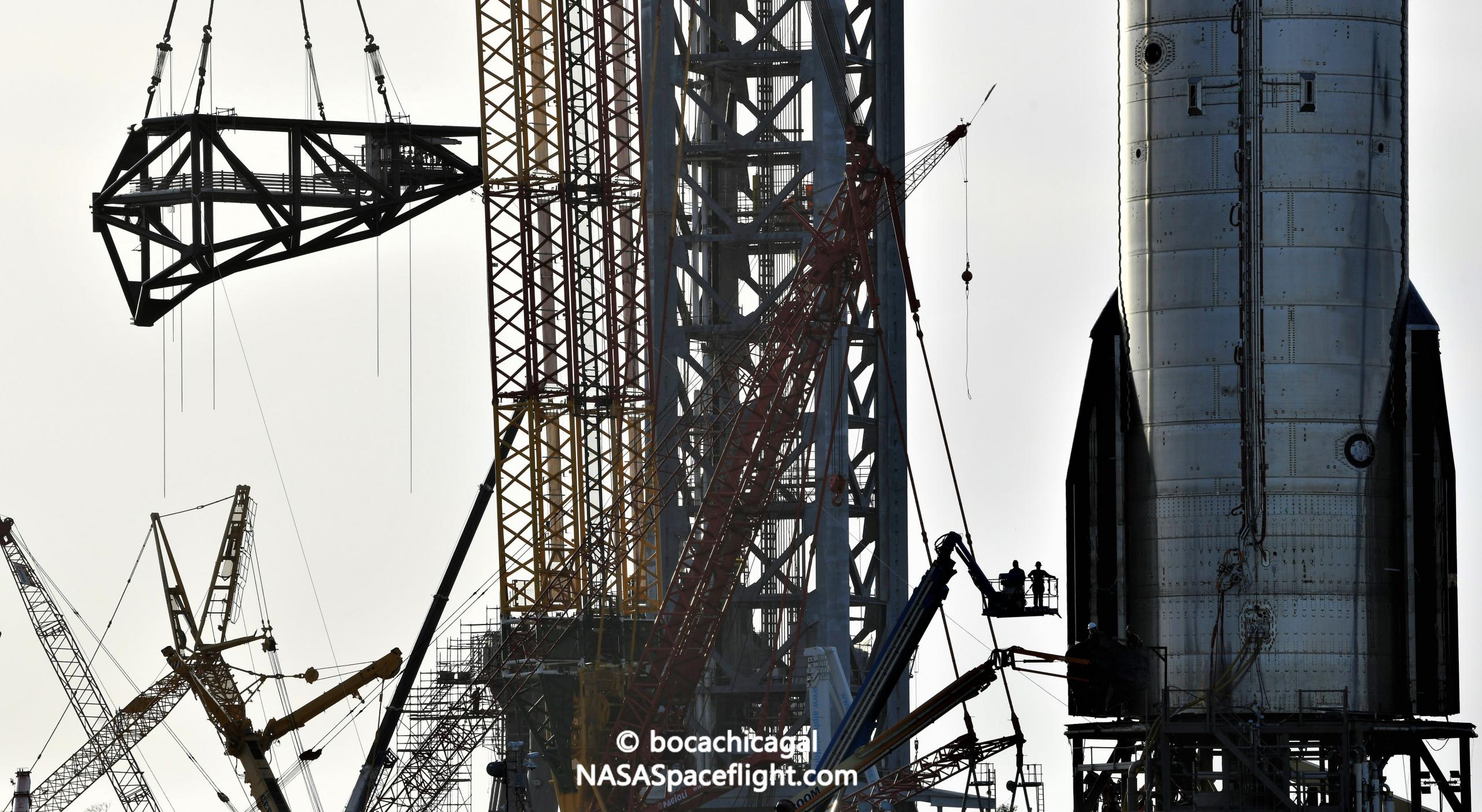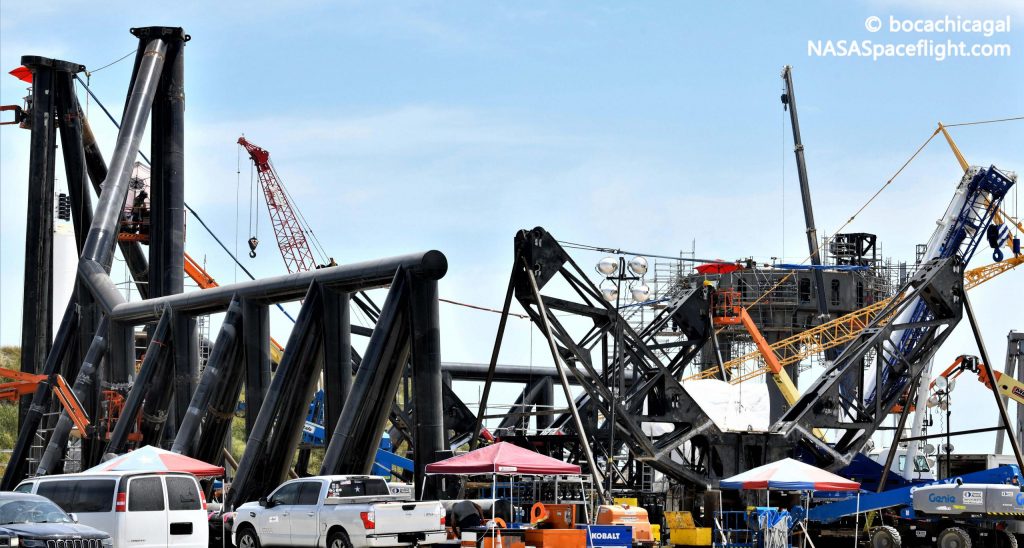

News
SpaceX installs first ‘Mechazilla’ arm on Starship launch tower
One month after SpaceX stacked Starship’s South Texas ‘launch tower’ to its full height, the company has installed the first arm on what amounts to the backbone of ‘Mechazilla.’
At the end of July, after less than four months of work, a team of SpaceX workers and contractors installed the final prefabricated section of a ~145m (~475 ft) tall tower meant to support orbital Starship launches. Above all else, SpaceX’s first custom-built ‘launch tower’ is a sort of backbone or anchor point for several massive, mechanical arms that will accomplish the actual tasks of servicing – and, perhaps, catching – Starships and Super Heavy boosters.
Work on all three of the arms expected to make up what SpaceX CEO Elon Musk has described as “Mechazilla” has been visibly underway since the last week of June as a small army of welders carefully assembled dozens of sections of heavy-duty steel pipe into house-sized frames. Almost exactly two months later, SpaceX has installed the first of those three arms on the exterior of Starship’s skyscraper-sized launch tower.
Known as the tower’s quick-disconnect or QD swing arm, the standalone structure is reportedly designed to accomplish a few different tasks. First, as its unofficial name might suggest, the QD arm will hold a quick-disconnect umbilical connector that will temporarily attach to the base of Starships to load them with fuel, oxidizer, and other consumables and link them to ground power and networking. For years, it appeared that SpaceX planned to fuel Starship upper stages through their Super Heavy boosters, which will themselves be connected to umbilical panels on a table-like launch mount that sits beside the tower.
However, once work began on Starship S20, the first potentially space-capable prototype, it was clear that SpaceX had foregone the umbilical plate normally installed at the base of Starship skirts and moved that connection to the ship’s lower back. Musk later confirmed as much in interviews and tweets, revealing that longstanding plans to dock Starships aft to aft for in-space refueling were also up in the air. As of late, aside from reiterating that the launch pad itself (“Stage Zero,” per Musk) is even more complex and difficult than Starship or Super Heavy, SpaceX’s CEO has also repeatedly stated a desire to offload as many systems as possible onto the launch pad – seemingly regardless of the complexity of the alternative.

Enter the building-sized robot informally known as Mechazilla. While the relatively simple swinging ‘QD arm’ that will fuel Starship and stabilize both stages of the rocket is a common feature of rockets and launch pads, the only experience SpaceX itself has with umbilical swing arms is the Crew Access Arm (CAA) that allows astronauts and cargo to board Dragon spacecraft after Falcon 9 goes vertical – a structure with near-zero umbilical utility. Technically, the transporter/erectors (T/Es) that cradle Falcon rockets, lift them vertical, and fuel them before launch have some similarities with swing arms but SpaceX has always used simpler and more reliable passive mechanisms whenever possible.
A step further, though, SpaceX has also seemingly foregone the installation of a basic crane on top of its Starship tower and Musk himself has developed an almost infamous aversion to the inclusion of something as seemingly simple as landing legs on Super Heavy boosters – and, eventually, perhaps even (some) Starship variants. Instead of adding rudimentary legs to Super Heavy prototypes, Musk has seemingly pushed SpaceX to turn Starship’s launch tower into a complex, vulnerable, and fragile rocket recovery system. Beyond the comparatively mundane QD arm, Musk says that SpaceX will ultimately install a pair of massive house-sized steel arms mounted on a sort of external elevator. Those arms will apparently be capable of actuating and moving up and down the tower with the speed, precision, and reliability needed to quite literally catch Super Heavy boosters – and, eventually, Starships – out of mid-air.
The team tasked with designing and building those rocket-catching arms have affectionately deemed them “chopsticks” – a nod towards the kind of nuanced actuation they’ll need to recover the world’s largest rocket boosters and upper stages without missing or destroying them. Having really only just perfected propulsive vertical landing with Falcon 9 and Falcon Heavy boosters, SpaceX thus intends to throw a few extra points of failure into the mix.
To SpaceX and Musk’s credit, whether the company’s second attempt at catching rockets goes as well as the first, some version of the massive ‘chopstick’ arms SpaceX is working on was likely going to be necessary just to rapidly turn around boosters and Starships – and do so regardless (within reason) of weather conditions. By replacing a tower crane with giant arms, SpaceX will hopefully be able to stack Starship on Super Heavy (and Super Heavy on the launch mount) even in the high winds that are almost always present on the South Texas Gulf Coast. If SpaceX can also reliably catch boosters with those arms, it could be a significant upgrade for the operations side of Starship reusability. For now, though, only time will tell.

Elon Musk
Elon Musk and Tesla AI Director share insights after empty driver seat Robotaxi rides
The executives’ unoccupied tests hint at the rapid progress of Tesla’s unsupervised Robotaxi efforts.

Tesla CEO Elon Musk and AI Director Ashok Elluswamy celebrated Christmas Eve by sharing personal experiences with Robotaxi vehicles that had no safety monitor or occupant in the driver’s seat. Musk described the system’s “perfect driving” around Austin, while Elluswamy posted video from the back seat, calling it “an amazing experience.”
The executives’ unoccupied tests hint at the rapid progress of Tesla’s unsupervised Robotaxi efforts.
Elon and Ashok’s firsthand Robotaxi insights
Prior to Musk and the Tesla AI Director’s posts, sightings of unmanned Teslas navigating public roads were widely shared on social media. One such vehicle was spotted in Austin, Texas, which Elon Musk acknowleged by stating that “Testing is underway with no occupants in the car.”
Based on his Christmas Eve post, Musk seemed to have tested an unmanned Tesla himself. “A Tesla with no safety monitor in the car and me sitting in the passenger seat took me all around Austin on Sunday with perfect driving,” Musk wrote in his post.
Elluswamy responded with a 2-minute video showing himself in the rear of an unmanned Tesla. The video featured the vehicle’s empty front seats, as well as its smooth handling through real-world traffic. He captioned his video with the words, “It’s an amazing experience!”
Towards Unsupervised operations
During an xAI Hackathon earlier this month, Elon Musk mentioned that Tesla owed be removing Safety Monitors from its Robotaxis in Austin in just three weeks. “Unsupervised is pretty much solved at this point. So there will be Tesla Robotaxis operating in Austin with no one in them. Not even anyone in the passenger seat in about three weeks,” he said. Musk echoed similar estimates at the 2025 Annual Shareholder Meeting and the Q3 2025 earnings call.
Considering the insights that were posted Musk and Elluswamy, it does appear that Tesla is working hard towards operating its Robotaxis with no safety monitors. This is quite impressive considering that the service was launched just earlier this year.
Elon Musk
Starlink passes 9 million active customers just weeks after hitting 8 million
The milestone highlights the accelerating growth of Starlink, which has now been adding over 20,000 new users per day.

SpaceX’s Starlink satellite internet service has continued its rapid global expansion, surpassing 9 million active customers just weeks after crossing the 8 million mark.
The milestone highlights the accelerating growth of Starlink, which has now been adding over 20,000 new users per day.
9 million customers
In a post on X, SpaceX stated that Starlink now serves over 9 million active users across 155 countries, territories, and markets. The company reached 8 million customers in early November, meaning it added roughly 1 million subscribers in under seven weeks, or about 21,275 new users on average per day.
“Starlink is connecting more than 9M active customers with high-speed internet across 155 countries, territories, and many other markets,” Starlink wrote in a post on its official X account. SpaceX President Gwynne Shotwell also celebrated the milestone on X. “A huge thank you to all of our customers and congrats to the Starlink team for such an incredible product,” she wrote.
That growth rate reflects both rising demand for broadband in underserved regions and Starlink’s expanding satellite constellation, which now includes more than 9,000 low-Earth-orbit satellites designed to deliver high-speed, low-latency internet worldwide.
Starlink’s momentum
Starlink’s momentum has been building up. SpaceX reported 4.6 million Starlink customers in December 2024, followed by 7 million by August 2025, and 8 million customers in November. Independent data also suggests Starlink usage is rising sharply, with Cloudflare reporting that global web traffic from Starlink users more than doubled in 2025, as noted in an Insider report.
Starlink’s momentum is increasingly tied to SpaceX’s broader financial outlook. Elon Musk has said the satellite network is “by far” the company’s largest revenue driver, and reports suggest SpaceX may be positioning itself for an initial public offering as soon as next year, with valuations estimated as high as $1.5 trillion. Musk has also suggested in the past that Starlink could have its own IPO in the future.
News
NVIDIA Director of Robotics: Tesla FSD v14 is the first AI to pass the “Physical Turing Test”
After testing FSD v14, Fan stated that his experience with FSD felt magical at first, but it soon started to feel like a routine.

NVIDIA Director of Robotics Jim Fan has praised Tesla’s Full Self-Driving (Supervised) v14 as the first AI to pass what he described as a “Physical Turing Test.”
After testing FSD v14, Fan stated that his experience with FSD felt magical at first, but it soon started to feel like a routine. And just like smartphones today, removing it now would “actively hurt.”
Jim Fan’s hands-on FSD v14 impressions
Fan, a leading researcher in embodied AI who is currently solving Physical AI at NVIDIA and spearheading the company’s Project GR00T initiative, noted that he actually was late to the Tesla game. He was, however, one of the first to try out FSD v14.
“I was very late to own a Tesla but among the earliest to try out FSD v14. It’s perhaps the first time I experience an AI that passes the Physical Turing Test: after a long day at work, you press a button, lay back, and couldn’t tell if a neural net or a human drove you home,” Fan wrote in a post on X.
Fan added: “Despite knowing exactly how robot learning works, I still find it magical watching the steering wheel turn by itself. First it feels surreal, next it becomes routine. Then, like the smartphone, taking it away actively hurts. This is how humanity gets rewired and glued to god-like technologies.”
The Physical Turing Test
The original Turing Test was conceived by Alan Turing in 1950, and it was aimed at determining if a machine could exhibit behavior that is equivalent to or indistinguishable from a human. By focusing on text-based conversations, the original Turing Test set a high bar for natural language processing and machine learning.
This test has been passed by today’s large language models. However, the capability to converse in a humanlike manner is a completely different challenge from performing real-world problem-solving or physical interactions. Thus, Fan introduced the Physical Turing Test, which challenges AI systems to demonstrate intelligence through physical actions.
Based on Fan’s comments, Tesla has demonstrated these intelligent physical actions with FSD v14. Elon Musk agreed with the NVIDIA executive, stating in a post on X that with FSD v14, “you can sense the sentience maturing.” Musk also praised Tesla AI, calling it the best “real-world AI” today.








